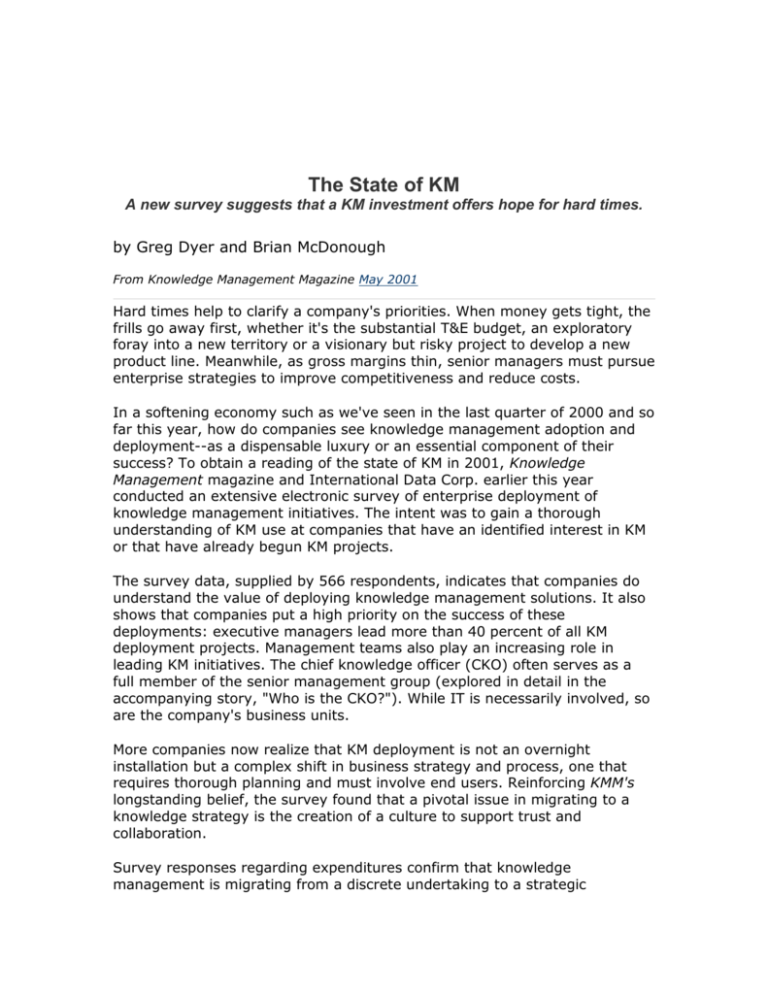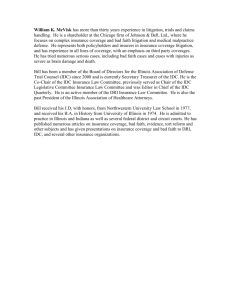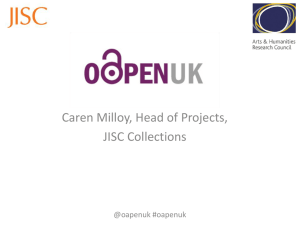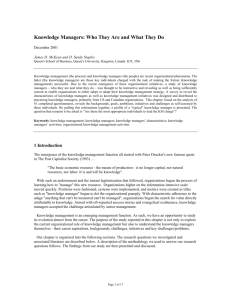The State of KM
advertisement

The State of KM A new survey suggests that a KM investment offers hope for hard times. by Greg Dyer and Brian McDonough From Knowledge Management Magazine May 2001 Hard times help to clarify a company's priorities. When money gets tight, the frills go away first, whether it's the substantial T&E budget, an exploratory foray into a new territory or a visionary but risky project to develop a new product line. Meanwhile, as gross margins thin, senior managers must pursue enterprise strategies to improve competitiveness and reduce costs. In a softening economy such as we've seen in the last quarter of 2000 and so far this year, how do companies see knowledge management adoption and deployment--as a dispensable luxury or an essential component of their success? To obtain a reading of the state of KM in 2001, Knowledge Management magazine and International Data Corp. earlier this year conducted an extensive electronic survey of enterprise deployment of knowledge management initiatives. The intent was to gain a thorough understanding of KM use at companies that have an identified interest in KM or that have already begun KM projects. The survey data, supplied by 566 respondents, indicates that companies do understand the value of deploying knowledge management solutions. It also shows that companies put a high priority on the success of these deployments: executive managers lead more than 40 percent of all KM deployment projects. Management teams also play an increasing role in leading KM initiatives. The chief knowledge officer (CKO) often serves as a full member of the senior management group (explored in detail in the accompanying story, "Who is the CKO?"). While IT is necessarily involved, so are the company's business units. More companies now realize that KM deployment is not an overnight installation but a complex shift in business strategy and process, one that requires thorough planning and must involve end users. Reinforcing KMM's longstanding belief, the survey found that a pivotal issue in migrating to a knowledge strategy is the creation of a culture to support trust and collaboration. Survey responses regarding expenditures confirm that knowledge management is migrating from a discrete undertaking to a strategic component of business solutions. In this migration, consultants remain key to KM deployments. Drivers and leadership While technology drove the initial interest in knowledge management in the United States, both vendors and end users have begun to realize that an effective KM solution must also address a business's people and processes. This new tripartite focus--on people, process and technology--enables the planning and adoption of solutions to meet an organization's business goals. The most common goals motivating a corporation to undertake an effort to manage knowledge better include retaining key talent, improving customer service and increasing revenues and profits (see the graph "Reasons for Adopting KM" ). Further questioning revealed the business needs underlying these goals. The majority of these organizations now focus on four uses of knowledge management: to capture and share best practices (77.7 percent), to provide training or corporate learning (62.4 percent), to manage customer relationships (58.0 percent) and to deliver competitive intelligence (55.7 percent) (see "Business Uses of KM Initiative"). Project collaboration, intellectual property management, enhancing Web publishing capability and improving supply chain management ranked lower as business drivers. BP Amoco PLC, the London-based energy conglomerate, illustrates this business-driven process. To increase profits, one business unit, BP Exploration, developed a pilot project in 1994 that focused on reducing exploration expenses by developing a "virtual teamwork" program to support collaboration among geographically dispersed offices. The project grew out of a reorganization from a few closely controlled regional operating centers to 42 separate businesses, each free to develop processes and solutions to serve local needs. The project aimed to let other areas of the company use locally designed best practices. With better collaboration, it was hoped, company managers could emphasize more efficient and creative decision-making. A 1995 equipment failure on a mobile drilling ship in the North Sea highlighted the benefits of this plan. The failure brought the ship's drilling and oil processing operations to a halt, at a cost of $150,000 per day. Using virtual teamwork, the engineers worked with an onshore expert to fix the problem. Operations remained down for only a few hours instead of a few days. More importantly, the knowledge gained from this collaboration was used to establish best practices that would be accessible across the organization. As corporate managers have learned about the bottom-line success of programs such as those at BP, interest in KM has grown rapidly. As a result, senior executives--including CEOs, CFOs, CIOs and CKOs--have increasingly become primary drivers of KM initiatives. Our survey found that corporate management leads 42 percent of respondents' initiatives (see "Leader of KM Initiative"). The survey found that decentralized leadership and cross-functional teams are widely used for providing leadership to KM initiatives. That executives do not lead more than one-fourth of the respondents' projects suggests that many KM initiatives still emerge at the grass-roots level. Despite the grassroots origin of KM, we now hear that CEOs increasingly involve themselves in KM decisions, causing organizations to take a more formal approach to the initiatives. The CKO position is also growing in prominence. IDC believes that the entire organization should have input in creating a KM initiative. Even departmental KM efforts should take into account the corporate mission and goals. Certainly, the IT department cannot work alone to implement KM. Buy-in from future users of the knowledge management solution is as important as making the right technology decisions. Long-term commitment Our survey reveals uncertainty regarding the amount of time it takes to develop and deploy a KM solution. While 63 percent of respondents had a project schedule of three years or less, another 22 percent had not set a time limit on their efforts (see "Planned Length of Project"). Therefore, companies that think an effective KM program can be planned and implemented in just a few years should beware. A knowledge management strategy represents a long-term initiative involving not only technology integration but also significant investment in change management and business process design. Successful KM implementations begin with input from future users. Small pilot projects can foster learning, show measurable results and management challenges, and then be expanded across a business process such as competitive analysis, business-to-business sales or customer service. Based on the KMM/IDC survey findings, an organization's main implementation challenge stems from the absence of a "sharing" culture in the organization and employees' lack of understanding of what knowledge management is and what benefits it offers (see "Implementation Challenges"). To address these challenges, companies must make training, change management and process redesign primary components of their KM initiatives. Although the focus on corporate culture and organizational change may extend the timeframe for a knowledge management program, only measurable benefits justify increased duration and cost. Those benefits include better preparation for implementation and the ability to take advantage of existing technology. Knowledge management investments are thus likely to include the extension of existing enterprise software to eliminate barriers between transactional applications and repositories of corporate knowledge. Increasingly, companies will exploit corporate knowledge and provide it to users within the context of business problems, a more effective alternative to simply storing this content in and accessing it from a centralized knowledge repository. Even as companies extend existing software systems, they will need to make new investments in certain technologies to support the KM initiative. The KMM/IDC survey found that substantial numbers of companies are purchasing messaging and e-mail, knowledge repository and document management tools to support corporate KM initiatives (see "Types of Software Purchased"). Spending on KM As KM systems progress from the planning phase to implementation, the expense of each initiative will increase due to the costs of deployed services and technology tools. Based on the survey results, IDC estimates that the average budget will increase from $632,000 in 2000 to more than $1 million in 2002. These figures fall lower than expected, we believe, because twofifths of the respondents represented companies with 500 or fewer employees. Past data that emphasized larger companies showed an average budget of $2.7 million in 2000. IDC also believes that the budgets specifically designated for "knowledge management" initiatives decrease as these efforts become part of other technology or business process investments. For example, a company may perceive itself as investing in a customer service solution, though one with significant knowledge management capability, rather than categorize this investment as a KM initiative. While most companies will try to maximize use of their internal resources, approximately 27 percent of knowledge management budgets are allocated for external resources. Of these external resources, IT services account for 34 percent of spending, software for 39 percent and management consulting for 29 percent. IT services spending in 2000 was nearly equally allocated between consulting or planning and implementation, while software spending focused on enterprise information portals (EIPs), document management and groupware applications (see "Spending on IT Services for KM" and "Software Budget Allotments"). The top five software product categories purchased to support the knowledge management efforts detailed in "Types of Software Purchased" provide the technology infrastructure for the project. Companies purchase EIPs and search engines to provide access to knowledge captured within the infrastructure. IDC expects the EIP market to benefit increasingly from infrastructure investments of the sort reported in "Software Budget Allotments." The knowledge management industry includes a host of service and technology providers, but the survey suggests that market leaders are beginning to emerge. According to the respondents' perceptions, Accenture, IBM Global Services and KPMG are the top service providers while IBM, Lotus and Microsoft are the leading suppliers of KM technology. Despite--or perhaps because of--the state of the economy, the knowledge management market will experience impressive growth as more companies begin to develop and implement knowledge management programs. The survey responses suggest that this growth will occur in companies of diverse sizes and industries. Furthermore, the majority of respondents reported that their programs have been in place for fewer than three years and currently are mostly in the review and planning stages. Corporate management is now realizing the importance of managing knowledge to solve business problems and beginning to take leadership roles in knowledge management programs in their organizations. As senior executives involve their organizations more fully in a KM initiative and begin to implement pilot programs, end users will learn the programs' benefits, adapt to the processes and technologies, and work more effectively in these newly collaborative and content-rich environments.











